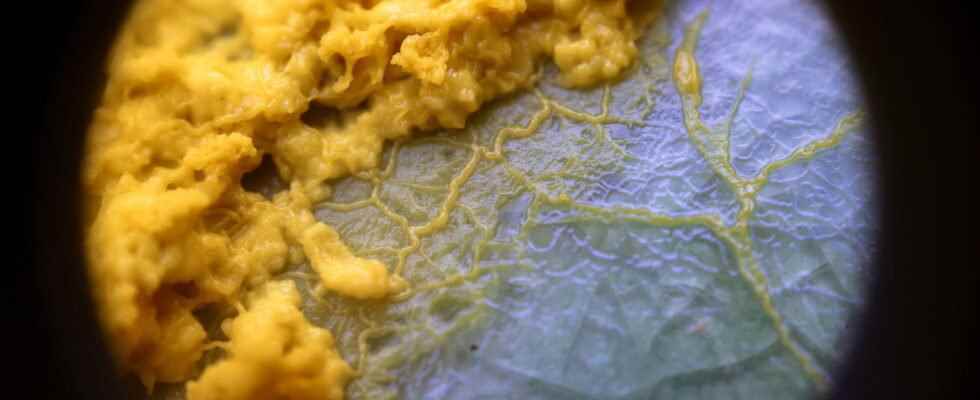This one-celled, almost immortal organism seems to be the trend of the moment. Some parents plan to give one to their child as a Christmas present. A French company even markets boxes containing two strains of the blob.
The blob, a new trendy Christmas gift?
Since the blob was taken aboard the ISS with Thomas Pesquet and French students continued to experiment at school, this fascinating species has become trending. Some parents have planned to give it as a Christmas present to their children. Looking for an original, educational, fun and scientific idea? Blobshop, a company located in the south of France offers original Christmas boxes, containing two stumps of blob (Badhamia and Ava), for the sum of 39 euros. There are oats, agar agar, a pipette, a spatula and a small forceps to feed the blob and help it grow. “There is really a very, very playful dimension. We don’t know how the blob will react, there are several species so they move differently, do not eat the same thing, they have different characters so there is everything. to study on it “, explained the founder of Blob Shop, Arnaud Peyron on France Inter. On the strength of its success, the company is often out of stock.
What is the blob? Why does this species fascinate scientists?
The blob is neither an animal, nor a fungus, nor a plant : it is part of the class of myxomycetes. His real name is physarum polycephalum. This single-celled species defies the laws of biology! Brainless, the blob nevertheless exhibits intelligent behavior. It does not have legs, wings or fins, and yet can move around. He is able to anticipate a change in his climatic environment, to find a shorter path out of a labyrinth, he can even learn. Another impressive feature of the blog: he is almost immortal, does not fear light or drought and if the conditions are not favorable, it goes into hibernation to survive and has more than 700 different sexes. This species which intrigues scientists would have appeared a billion years ago.
Funny porthole you say to me! This is a #blob (or slime mold, Physarum polycephalum) placed in the center of an airtight box with some oatmeal around it, in preparation for its departure to the International Space Station (#ISS) in ju https://t.co/Iosh3TBjL6 pic.twitter.com/QVnUwQrEjB
– National Center for Scientific Research (@CNRS) April 19, 2021
“Behind the blob, the research”
After the experiments around the blob in schools, the CNRS launched, last October, a participatory science project entitled Behind the blob, the search. 10,000 volunteers, from the age of 8, could take part in a research project on the effects of climate change on the blob. For a period of one week to one month, depending on the availability of each, the candidates had for mission to hydrate and nourish a blob and a cousin species at their home. They are encouraged to vary temperatures and exposure times in order to simulate heat waves and collect data. These will then be collected by the team from the Center for Research on Animal Cognition-CBI (CNRS / UPS). This project has two objectives: to make the participants aware of the setting up of a scientific study and to allow them to participate in a unique experience.
Raise your blob: experiments in schools
The experiments around the blob took place from October 11 to October 19 in more than 4,500 classes in France with the operation “Raise your blob “. Students from CE2 to Terminale thus took part in an unprecedented experience, orchestrated by the CNES (National Center for Space Studies), located in Toulouse, and Thomas Pesquet from space. The objective of this operation: compare the behavior of the blob on Earth and in space, weightless. At the start of the school year, the teachers received “blob kits” to start the breeding of this species composed of a single cell, having an astonishing form of animal life. Each school received 4 dehydrated blobs, gradually rehydrated and studied, fed, so that the students could see how they are growing. For his part, Thomas Pesquet, who took off on April 23 at aboard SpaceX’s “Crew Dragon” as part of the mission called Crew-2, for a six-month mission, had taken with him blobs in dehydrated form. Students, teachers and astronauts then sought to understand how this specimen, ultra resistant to terrestrial conditions, reacts in space, if it is able to develop despite weightlessness for example. Scientists will use them for various experiments. One of them will consist of wake up a blob (by giving it water) and photographing it to capture each stage of its evolution.
Thomas Pesquet raises a blob aboard the ISS
The French astronaut spoke about it on his Instagram account when the mission was launched, explaining what was going to be done once in space, not without a certain dose of humor, evoking all the extraordinary scenarios already told in various horror films. “It’s been a while since I talked about scientific research and yet that is the purpose of the Space Station! I will try to describe the experiments that are carried out there … although sometimes it is complicated, including for us to understand them “ he joked. “There is one that amuses me, it is to raise a blob in the ISS. Beyond remembering a horror movie that was already old when I was young, it is a fascinating organism, neither animal nor plant nor mushroom, without brain, and yet he is able to learn, to seek his food, and even to communicate (in the end a little the same skills as an astronaut). We are going to raise a few in the station … trying not to think too much about the disaster movie scenarios that it evokes.. “
